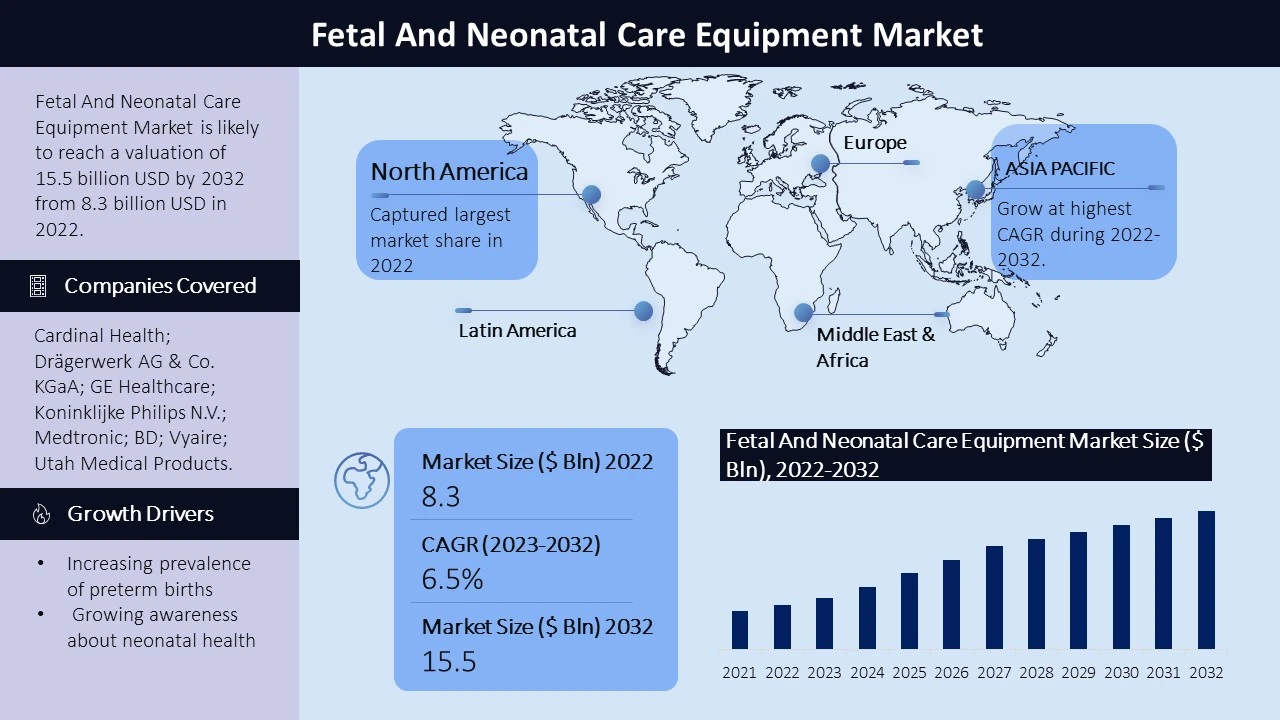Fetal And Neonatal Care Equipment Market: Current Trends and Future Business Opportunities 2022-2032
Market Size and Overview:
The global fetal and neonatal care equipment market had a value of USD 8.3 billion in 2022, and it is projected to grow at a compound annual growth rate (CAGR) of 6.5% from 2023 to 2030. The market is driven by various factors, including high birth rates in developing countries, the prevalence of premature births, and government initiatives to improve the survival rates of newborns. Additionally, the increasing awareness about newborn care equipment and the rising incidence of nosocomial infections in newborns contribute to market growth. The demand for fetal and neonatal care equipment is expected to continue growing due to the increasing focus on maternal and child health in middle-income countries and the rising prevalence of preterm hypothermia. Key players in the industry are focused on developing innovative solutions to cater to the specific needs of newborns and enhance their overall care and well-being.
Market Segmentation:
Product Type:
Fetal Care Equipment
- Ultrasound Devices
- Fetal MRI Systems
- Fetal Monitors
- Fetal Pulse Oximeters
Neonatal Care Equipment
- Infant Warmers
- Incubators
- Convertible Warmers & Incubators
- Phototherapy Equipment
- Respiratory Devices
- Neonatal Monitoring Devices
- Others
End-Users:
- Hospitals
- Neonatal Clinics
- Birthing Centers
- Others
Geographic Regions:
- North America
- Europe
- Asia Pacific
- Latin America
- Middle East and Africa
Incubators: The incubators segment holds a significant market share in the fetal and neonatal care equipment market. These devices play a crucial role in providing a controlled environment for premature babies, maintaining their body temperature, and protecting them from external factors. With the increasing incidence of preterm births globally, the demand for incubators is expected to grow consistently.
Hospitals: The hospital segment represents the largest end-user in the fetal and neonatal care equipment market. Hospitals have the necessary infrastructure, resources, and expertise to provide comprehensive care for newborns. The increasing investments in healthcare infrastructure, particularly in emerging economies, contribute to the growth of this segment.
Regional Analysis:
The regional analysis of the fetal and neonatal care equipment market highlights distinct trends and dynamics across different regions. North America, particularly the United States, dominates the market, driven by advanced healthcare facilities, high awareness about neonatal health, and supportive reimbursement policies. Europe also holds a significant market share, with countries like Germany, the United Kingdom, and France being key contributors. The region's well-established healthcare infrastructure and emphasis on quality neonatal care contribute to its growth.
In the Asia Pacific region, rapid urbanization, improving healthcare infrastructure, and increasing healthcare expenditure are fueling market expansion. Countries like China and India are witnessing significant growth, driven by a large population base and rising awareness regarding neonatal health.
Latin America and the Middle East and Africa exhibit potential growth opportunities, attributed to improving healthcare systems, increasing investments in healthcare infrastructure, and growing awareness about neonatal care. Brazil, Mexico, the United Arab Emirates, and South Africa are key markets within their respective regions.

Growth Drivers:
Several factors are driving the growth of the fetal and neonatal care equipment market. Firstly, the increasing prevalence of preterm births is a major driver. Preterm birth rates have been rising globally, necessitating specialized care and equipment to ensure the well-being of premature babies. The demand for fetal and neonatal care equipment is directly influenced by the number of preterm births, and this trend is expected to continue.
Additionally, growing awareness about neonatal health and the importance of early intervention contribute to market growth. Parents and healthcare providers are increasingly focused on ensuring optimal care for newborns, driving the demand for advanced equipment that aids in monitoring and treating neonatal conditions.
Furthermore, technological advancements play a significant role in the market's expansion. Continuous innovations in fetal and neonatal care equipment have led to the development of more efficient and user-friendly devices. Advanced features, such as integrated monitoring systems and non-invasive techniques, enhance the accuracy and effectiveness of neonatal care.
Moreover, the increasing investments in healthcare infrastructure, particularly in emerging economies, are expected to propel market growth. Governments and healthcare organizations are recognizing the need to enhance neonatal care facilities and equip hospitals with advanced technology, driving the demand for fetal and neonatal care equipment.
Challenges:
The fetal and neonatal care equipment market faces challenges such as high costs associated with advanced equipment, limited accessibility in developing regions, and the need for specialized training for healthcare professionals. Additionally, stringent regulatory requirements for product approval and concerns regarding the safety and efficacy of certain devices pose challenges to market growth.
Key Companies:
The fetal and neonatal care equipment market is highly fragmented, with the presence of various players. Some prominent companies in the market include Cardinal Health; Drägerwerk AG & Co. KGaA; GE Healthcare; Koninklijke Philips N.V.; Medtronic; BD; Vyaire; Utah Medical Products, Inc.; Ambu A/S; Natus Medical Incorporated; Inspiration Healthcare Group plc.; Atom Medical Corp; Fisher & Paykel Healthcare Limited; Masimo; Phoenix Medical Systems (P) Ltd. These companies work closely with childcare providers to increase awareness and drive product sales. They focus on product approvals and launches to stay competitive in the market. For example, Pulsenmore Ltd., an Israeli company, launched a remote handheld ultrasound device that allows pregnant women to perform ultrasound scans at home. The market is characterized by continuous innovation and technological advancements to meet the evolving needs of healthcare providers and improve patient outcomes.

Need Customized Report for Your Business ?
Utilize the Power of Customized Research Aligned with Your Business Goals
Request for Customized Report- Quick Contact -
- ISO Certified Logo -

















